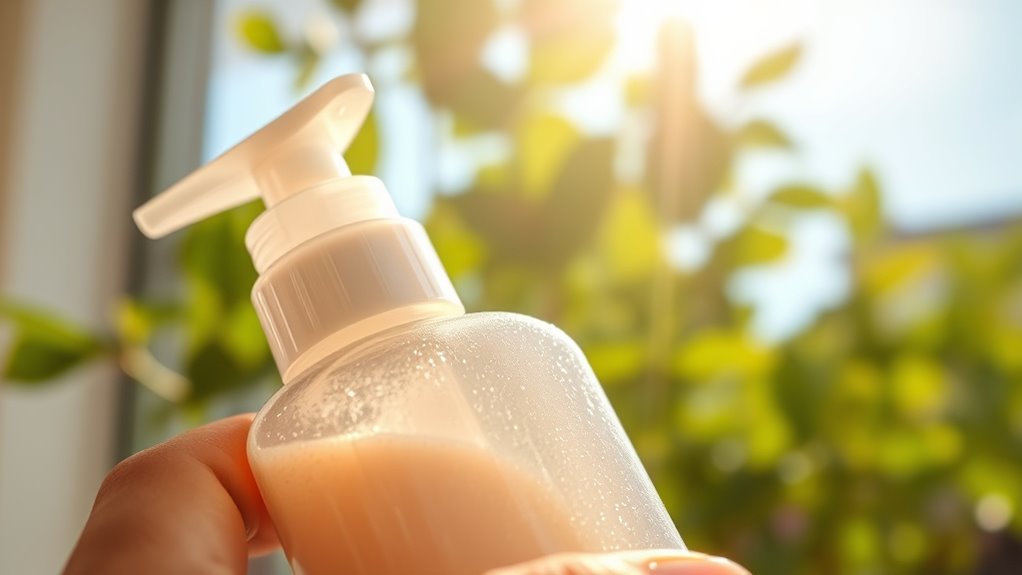SPF measures how long your skin stays protected from UVB rays before burning, with higher levels offering longer protection. Sunscreens form a barrier that absorbs or reflects UV rays to prevent damage, but proper application and reapplication are key. Broad-spectrum options shield against both UVB and UVA rays, which contribute to aging. To fully understand how SPF works and how to choose the right protection, keep exploring these important sun safety basics.
Key Takeaways
- SPF measures how much longer skin can stay unburned with sunscreen compared to unprotected skin.
- Sunscreens contain chemical or mineral filters that absorb or block UV radiation.
- Broad-spectrum sunscreens protect against both UVB rays (causing burns) and UVA rays (causing aging).
- Proper application, including generous and even coverage, enhances sunscreen effectiveness.
- Reapplying sunscreen every two hours, especially after swimming or sweating, maintains protection.
What Is SPF and How Is It Measured?
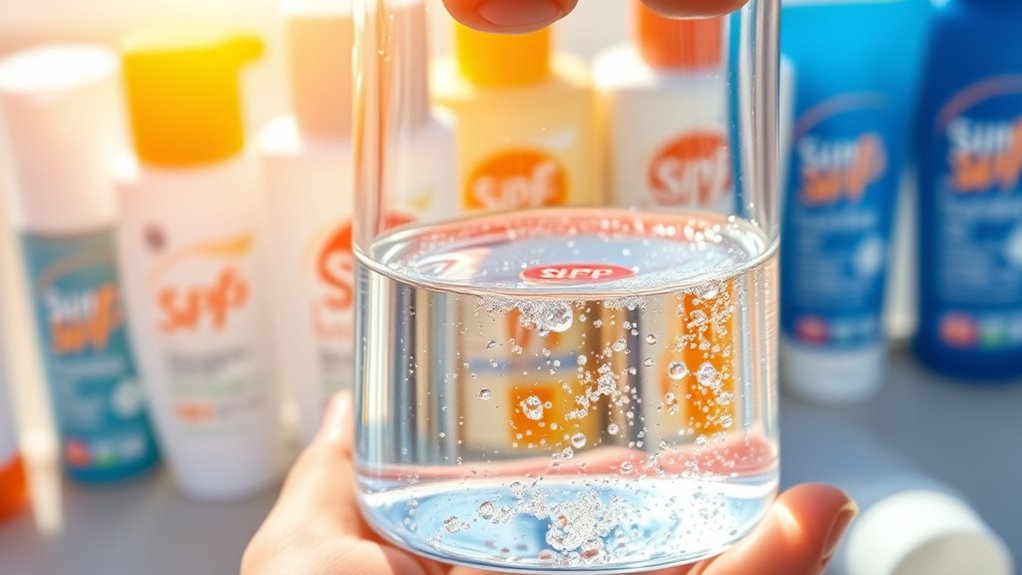
Have you ever wondered what SPF really measures? SPF testing determines how long your sunscreen protects you from UVB rays, which cause sunburn. It’s a numerical value that indicates the amount of time your skin stays safe before burning compared to unprotected skin. For example, SPF 30 means you can stay in the sun 30 times longer without burning. But SPF doesn’t tell the full story—UVA protection is also essential, as UVA rays penetrate deeper and contribute to aging and skin damage. Broad-spectrum protection is important because some products include broad-spectrum labeling to show they protect against both UVA and UVB rays. Understanding how SPF is measured helps you choose the right sunscreen for effective, thorough sun protection. Proper application of sunscreen is crucial for optimal effectiveness and should be complemented with other sun safety practices. Additionally, selecting sunscreens with appropriate SPF levels based on your skin type and environment can further enhance your protection.
The Science Behind Sunscreen Protection
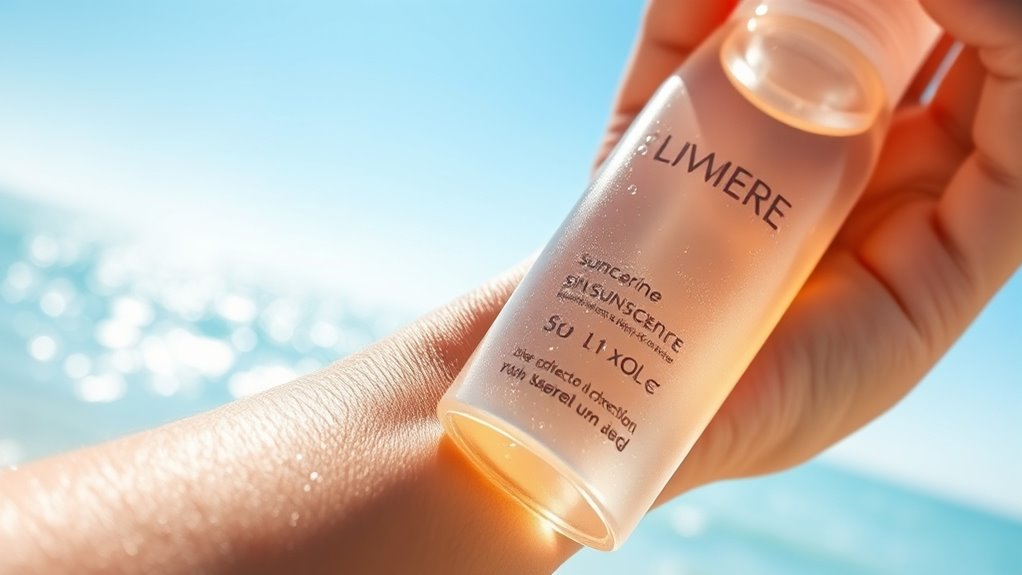
Ever wonder how sunscreen actually blocks harmful UV rays? It all comes down to chemical filters, which absorb UV radiation before it reaches your skin. These filters transform UV energy into heat, preventing damage and premature aging. Sunscreens form a protective barrier that allows you to enjoy the outdoors confidently, knowing you’re shielded from invisible threats. When UV radiation hits, chemical filters work tirelessly to:
- Absorb UV rays, reducing skin exposure
- Convert harmful energy into harmless heat
- Protect against both UVA and UVB rays
- Minimize risks of sunburn and skin damage
- Support your skin’s health and youthfulness
- Additionally, choosing a broad-spectrum sunscreen ensures comprehensive protection across the entire UV spectrum, which is crucial for maintaining healthy skin over time. Proper application techniques, such as applying sunscreen generously and reapplying regularly, enhance their effectiveness and provide better UV protection. Understanding this science helps you appreciate how sunscreens serve as your first line of defense, transforming complex chemistry into simple protection for your skin’s future. Additionally, using a low heat setting on your curling iron can prevent damage to your skin and synthetic wigs, much like how proper sunscreen application protects your skin from UV damage.
How SPF Affects Your Skin’s Defense
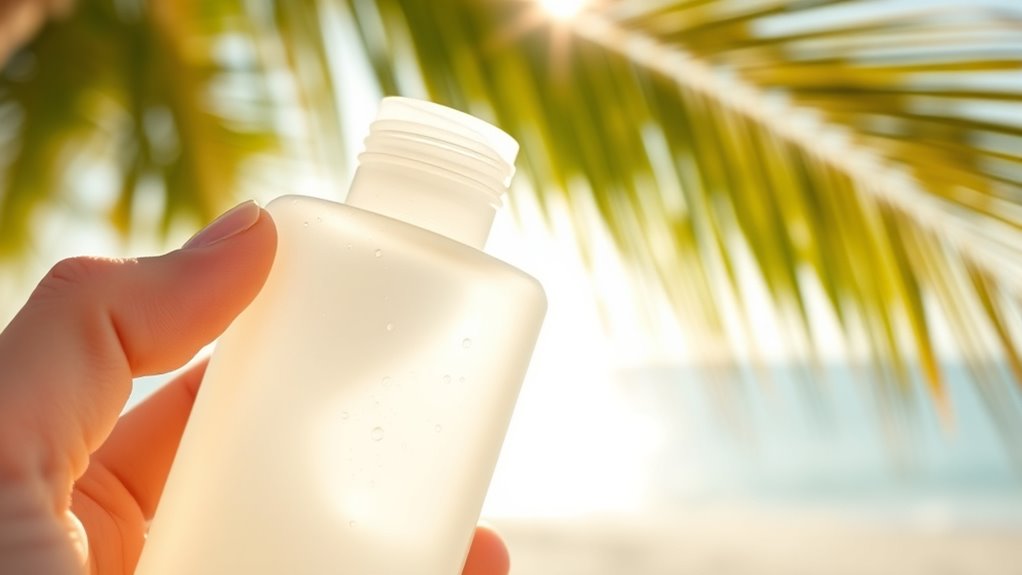
Choosing the right SPF level helps protect your skin from sun damage and reduces the risk of long-term harm. Higher SPF sunscreens block more UV rays, enhancing your skin’s natural defenses. Understanding how SPF impacts your skin allows you to make smarter choices for sun safety. Incorporating knowledge about protective styling benefits can further improve your overall sun protection strategy. Additionally, being aware of emerging AI-driven technologies can help you stay informed about innovative sun protection products and methods, which may include personalized sun safety recommendations based on individual skin types and exposure patterns.
SPF and Sun Damage
How does SPF truly protect your skin from sun damage? It filters and reduces the UV rays that reach your skin, preventing them from causing harm. The right SPF shields your skin from immediate damage like burns and long-term issues such as premature skin aging. When UV rays penetrate deeply, they can break down collagen, leading to wrinkles and fine lines. By choosing an appropriate SPF, you actively defend against these effects, keeping your skin healthier and younger-looking. Developing a demo reel can also help you showcase your vocal range and attract more opportunities in the voice acting industry. Additionally, understanding the different filter types used in various sunscreens ensures you select the best protection for your skin type and environment.
SPF Levels and Skin
Understanding SPF levels is crucial because different ratings offer varying degrees of protection based on your skin type and sun exposure. Higher SPF sunscreens block more UV rays, reducing your risk of UV reflection that can bounce off surfaces like water or sand. This is especially important if you spend a lot of time outdoors, as increased UV reflection can lead to faster skin aging. Lower SPF products may be suitable for brief sun exposure, but for prolonged periods, a higher SPF provides better defense. Remember, no sunscreen is entirely UV-proof, but choosing the right SPF helps protect your skin from damage and premature aging. Skin protection is enhanced when you select the appropriate SPF for your needs. Always reapply regularly, especially after swimming or sweating, to maintain effective protection. Additionally, understanding UV reflection can help you better appreciate why higher SPF levels are recommended for outdoor activities. Being aware of automated protection methods can also complement your sun safety practices.
Factors That Influence Sunscreen Effectiveness
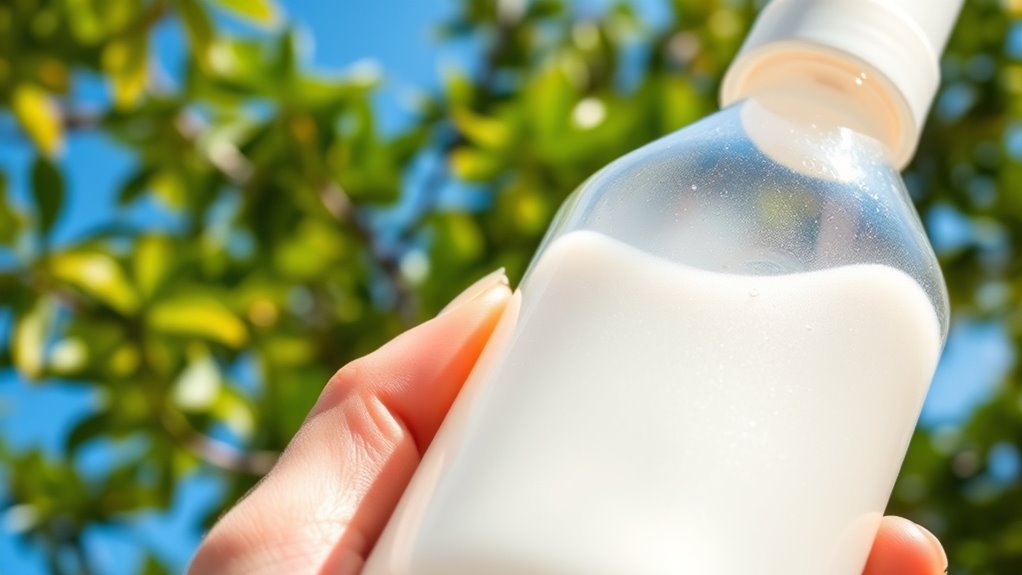
Several factors can impact how well your sunscreen protects your skin, making it important to contemplate them when selecting and applying SPF products. UV reflection from surfaces like water or sand can increase your exposure, reducing sunscreen effectiveness. Different sunscreen formulations, whether chemical or mineral, vary in how they absorb or block UV rays, so choosing the right type matters. Your application habits also play a role; applying too little or unevenly leaves skin vulnerable. Sweating, towel drying, or swimming can wash away protection, so reapplication is vital. Additionally, environmental conditions like humidity or wind can affect how well your sunscreen performs, emphasizing the need for mindful use to ensure maximum protection. proper application techniques are essential for maximizing the benefits of your sunscreen. Being aware of the diffusion of UV rays can help you better understand how environmental factors influence UV exposure and sunscreen effectiveness. Maintaining regular maintenance and cleaning of your sunscreen storage area can prevent contamination and ensure product efficacy.
Choosing the Right SPF for Your Skin and Activities
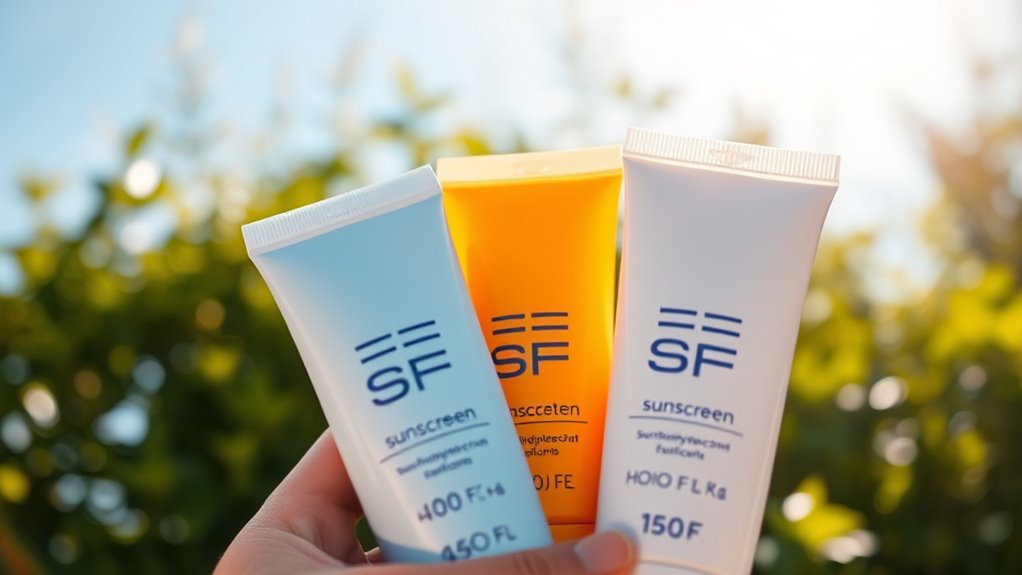
Choosing the right SPF depends on your skin type, the intensity of sun exposure, and your planned activities. If you have fair skin or are exposed to strong sunlight, opt for higher SPF (30-50). For everyday outdoor activities with moderate sun, SPF 15-30 usually suffices. For active pursuits like swimming or sports, choose water-resistant formulas with SPF 30+ to guarantee protection. Use the table below as a quick guide:
| Skin Type | Activity Level |
|---|---|
| Fair or sensitive skin | Low to moderate outdoor activities |
| Tanned or darker skin | High activity or prolonged exposure |
| Light skin | Intense sun exposure |
| Medium skin | Regular outdoor activities |
| Darker skin | Short outdoor periods |
Adjust SPF based on your skin type and activity level to best protect your skin. Additionally, selecting appropriate sun protection can enhance your skincare routine and prevent damage from UV rays. Understanding SPF effectiveness can help you select the most suitable sunscreen for optimal protection. Regularly reapplying sunscreen during outdoor activities is essential for continuous protection.
The Difference Between Broad-Spectrum and Regular Sunscreens
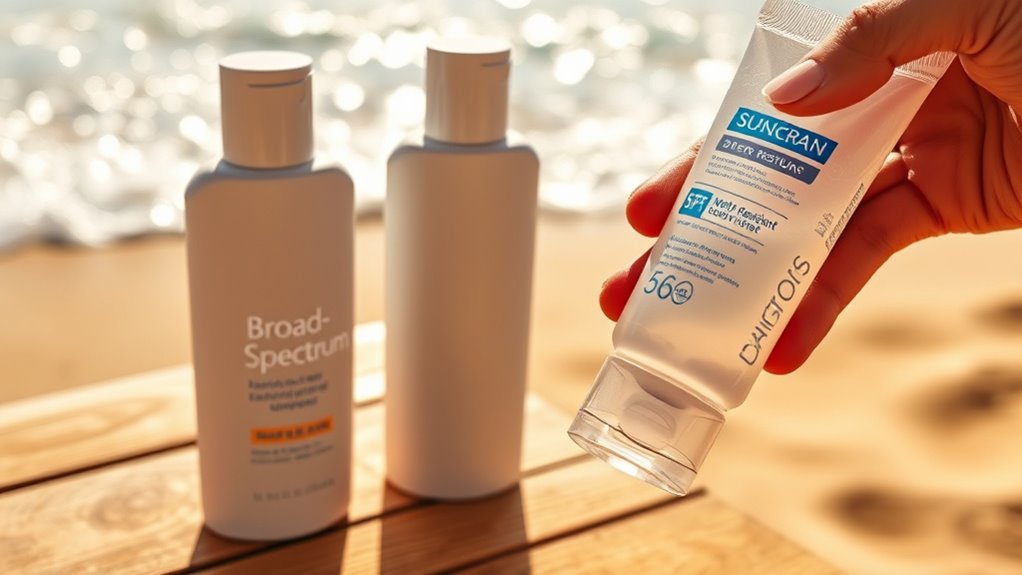
When selecting a sunscreen, it’s important to recognize the difference between broad-spectrum formulas and regular sunscreens. Broad-spectrum sunscreens offer protection against both UVA and UVB rays, which are vital for maintaining your skin barrier and preventing skin damage. Regular sunscreens may only shield you from UVB rays, leaving your skin vulnerable. Incorporating advanced sun protection technology into your skincare routine can further enhance your defenses against harmful rays. Choosing broad-spectrum gives you peace of mind knowing you’re protecting your skin’s health. Here’s why it matters:
- Safeguards your skin barrier from long-term damage
- Shields against aging caused by UVA rays
- Reduces risk of skin cancer
- Provides all-encompassing UV protection
- Keeps your skin resilient and youthful
- Understanding the importance of comprehensive protection can help you make better choices for your skin’s health.
Opt for broad-spectrum to guarantee your skin gets complete protection and stays healthy.
Proper Application and Reapplication of Sunscreen
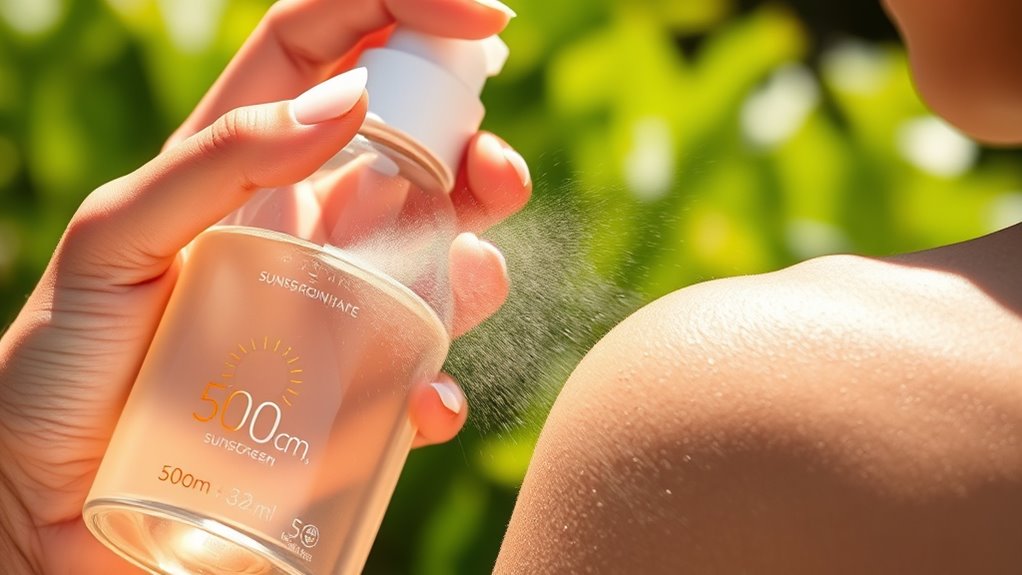
To safeguard your skin effectively, apply sunscreen generously and evenly across all exposed areas. Remember to reapply every two hours, especially if you’re swimming or sweating. Make sure no spot is left uncovered to ensure maximum protection. Additionally, using proper application techniques can significantly enhance the effectiveness of your sunscreen.
Applying Generously and Evenly
Have you ever wondered if you’re applying enough sunscreen? Proper application technique makes all the difference in ensuring coverage uniformity. To protect your skin effectively, apply a generous amount—about a shot glass full for your body and a teaspoon for your face. Use smooth, even strokes to distribute the sunscreen across all exposed areas. Don’t forget spots like your ears, neck, and behind the knees. When you apply generously and evenly, you reduce the risk of sunburn and long-term damage. Feel confident knowing you’re giving your skin the best defense possible. Remember, a thorough and even application ensures your SPF does its job and shields you from harmful UV rays. Your skin’s health depends on it.
Reapply Every Two Hours
Even if you’ve applied sunscreen thoroughly at the start of your day outdoors, it’s essential to reapply every two hours to maintain protection. Sunscreen ingredients can wear off due to sweating, water exposure, or towel drying, reducing UV protection. Reapplying guarantees your skin remains protected against harmful UV rays. Use enough sunscreen to cover all exposed areas, and pay attention to areas that may have been missed initially. Choose sunscreens with broad-spectrum ingredients that protect against both UVA and UVB rays. Remember, even water-resistant formulas need reapplication after swimming or heavy sweating. By reapplying every two hours, you help sustain the effectiveness of your sunscreen, preventing skin damage and reducing your risk of sunburn. Staying vigilant about reapplication is key to long-lasting UV protection.
Cover All Skin Areas
Applying sunscreen thoroughly isn’t enough if you miss spots or neglect certain areas. To truly protect your skin, make sure you cover all skin areas, including often overlooked spots. Pay special attention to face coverage, applying enough to shield every inch of your face. Don’t forget your ears, neck, and the tops of your feet. Use clothing protection—like wide-brim hats and UPF-rated clothing—to add an extra layer. Reapply sunscreen after swimming or sweating, and don’t skip hard-to-reach spots. Remember, neglecting even small areas can lead to sun damage. Covering all skin areas with consistent, thorough application minimizes your risk of burns and skin issues. Protect yourself by being meticulous—your skin will thank you for it.
Common Myths About SPF and Sun Protection

Many people believe that high SPF sunscreens provide foolproof protection, but this is a common myth. Myth busting reveals that higher SPF doesn’t mean your skin is invincible. SPF misconceptions often lead to overconfidence, causing you to stay in the sun longer without reapplying sunscreen. In reality, no sunscreen blocks 100% of UV rays, regardless of SPF number. SPF mainly indicates how long you can stay in the sun without burning compared to no protection. Overestimating SPF can give a false sense of security, increasing your risk of damage. It’s essential to understand that sunscreen is just one part of sun safety. Proper application, reapplication, and seeking shade remain essential to effectively protect your skin from harmful UV radiation.
Additional Sun Safety Tips to Complement Sunscreen Use
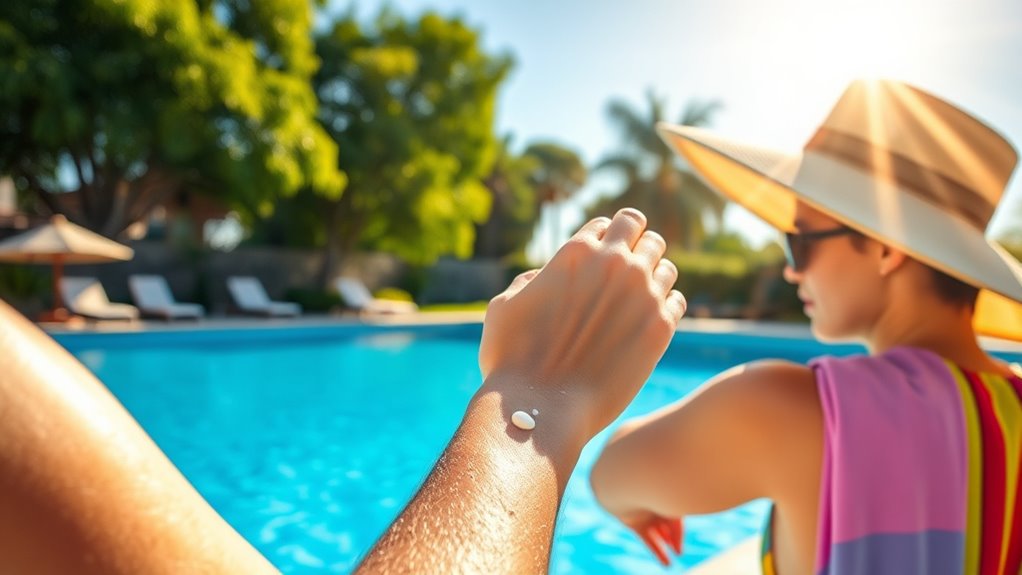
To maximize your sun protection, it’s important to incorporate additional safety measures alongside sunscreen. Monitoring the UV index helps you understand when UV rays are strongest, so you can adjust your sun safety routine accordingly. Seek shade during peak hours, typically between 10 a.m. and 4 p.m., and wear protective clothing like wide-brimmed hats and UV-blocking sunglasses. Remember, shade and clothing add vital layers of defense. Applying these habits can prevent painful sunburns and long-term skin damage.
Monitoring the UV index and seeking shade during peak hours enhances your sun safety routine.
- Feel the warmth of the sun, but don’t let it scorch your skin
- Protect your eyes with stylish, UV-blocking sunglasses
- Cover up to shield your skin from harmful rays
- Stay in the shade during peak UV hours
- Listen to the UV index—your guide to safer sun exposure
Frequently Asked Questions
Can Certain Foods Enhance or Reduce Sunscreen Effectiveness?
Certain foods can influence your sunscreen’s effectiveness through food interactions and dietary impact. For example, citrus fruits and foods rich in antioxidants might enhance your skin’s resilience, while alcohol and medications like antibiotics can reduce sunscreen’s protective power. To maximize protection, maintain a balanced diet, stay hydrated, and be mindful of how specific foods and drinks may interact with your skin’s response to UV exposure.
How Does SPF Relate to UVA and UVB Protection Levels?
Think of SPF as your shield in a battle against the sun. Higher SPF mainly boosts UVB Protection, helping prevent burns, while it also reduces UVA Penetration, which ages your skin. A broad-spectrum sunscreen offers balanced protection against both. So, when choosing SPF, consider your exposure: a higher SPF guards better against UVB and UVA rays, keeping your skin safer and younger-looking longer.
Are There Natural or Organic Sunscreens With High SPF Ratings?
Yes, you can find natural or organic sunscreens with high SPF ratings. These products use natural ingredients and organic formulations to provide effective sun protection without synthetic chemicals. Look for labels that specify broad-spectrum protection and high SPF, such as SPF 30 or higher. Keep in mind, though, that higher SPF doesn’t mean you can stay in the sun longer without reapplying. Always verify ingredient lists to confirm they meet your preferences.
How Does Skin Type Influence the Choice of SPF?
Your skin type plays a big role in choosing the right SPF. If you have sensitive skin, opt for a higher SPF to better protect against sun exposure management and reduce irritation. Those with fair skin should consider higher SPFs, while darker skin tones might need slightly less. Understanding your skin sensitivity helps you select an SPF that offers adequate protection without causing discomfort, ensuring you enjoy sun safely.
Can Sunscreen Expire or Lose Effectiveness Over Time?
Think of your sunscreen as a hero with a limited battle shelf life. Over time, its strength wanes, like a knight losing armor. Yes, sunscreen can expire or lose effectiveness, especially if it’s past its expiration date. The sunscreen shelf life matters because expired products may not shield you properly. Always check the expiration date; a fresh bottle means a stronger defense against harmful UV rays.
Conclusion
Think of SPF as your shield in the sun’s battlefield. When you choose the right SPF and apply it properly, you’re arming yourself against UV damage. Remember, no shield is foolproof—reapply, seek shade, and wear protective clothing. With these strategies, you’ll stand strong against the sun’s assault, keeping your skin safe and healthy. Stay vigilant, and let your sunscreen be your trusty armor on every sunny adventure.
